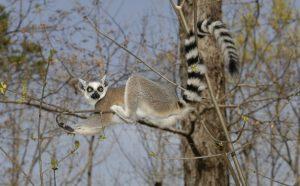The ring-tailed lemur, easily recognizable from its black and white striped tail, is an icon of Madagascar. Referred to as “maky” in the local language, it is also called “catta” in Latin after its cat-like appearance. Though famed worldwide due to its attractive look, it has faced a massive population decline, about 95% since 2000.
Table of Contents
Scientific ClassificationAnimaliaChordataMammaliaPrimatesLemuridaeLemurL.catta Table Of ContentTable of Contents
Scientific ClassificationAnimaliaChordataMammaliaPrimatesLemuridaeLemurL.cattaTable of Contents
 Ring Tailed LemurDescription
Ring Tailed LemurDescriptionHeight: 37-43 inches (95-100 cm), including tail length
Weight: 4.9 lb (2.2 kg)
Face and eyes: Like all strepsirrhine primates, they have a protruding muzzle and a wet nose.
Tail: Their striped tail appears long and bushy.
Body: It is larger than most lemurs, almost of the size of a house cat, with a furry body and tufted ears.
Coloration: They have gray to rosy brown backs with white bellies. Their tails consist of alternating white (12-13) and black (13-14) rings, ending in a black tip. These lemurs also have a white face, back nose, and triangular eye patches. When it comes to eye coloration, it is yellow in adults and blue in juveniles.
VideoRange and DistributionThe ring-tailed lemur is found only in southern and southwestern Madagascar.
The protected regions include five national parks in their home country, several nature reserves, and some unprotected forest areas.
Do they migrate?Females stay with their original groups, while males migrate after reaching sexual maturity.
The troop moves to a new location every 3-4 days, not traveling too far, at most 0.62 mi at a time from their original place.
 Ring Tailed Lemur Habitat
Ring Tailed Lemur Habitat Ring Tailed Lemur EyesHabitat
Ring Tailed Lemur EyesHabitatIt inhabits deciduous and gallery (lying near riverbanks) forests.
LifespanThe ring-tailed lemur lives for about 18 years.
What do they eat?Being omnivores, these lemurs feed on flowers, leaves, fruits, and insects.
BehaviorThey live in troops of 6–30, led mainly by a dominant female.An excellent camaraderie in the group is observed, especially during the early morning sunning ritual. The troops assemble in open areas to sunbathe in a unique lotus or sun-worshipping posture. Their bellies face the sun, and limbs remain outstretched. In this way, they keep themselves warm before foraging.These terrestrial lemurs spend much time on the ground running and moving about. At the same time, they are excellent jumpers, rising to about 3 meters vertically.They display aggression and hostility, especially while striving to protect their territory.When troops travel, they raise their tails in the air like flags in a manner that the bright portion is visible. In this way, the group can stay together. The tail may even serve as a signal to warn each other in case of any danger.They are diurnal, but can remain active after dark if the need arises because of their specialised night vision. A unique behavioral adaptation observed in these lemurs by scientists was their tendency of sleeping in the same cave each night and not switching staying places, unlike most other primates.Like most true lemurs, they cannot swim. Dancing Ring Tailed Lemur
Dancing Ring Tailed Lemur Ring Tailed Lemur FeetWhy Do the Females Dominate Males?
Ring Tailed Lemur FeetWhy Do the Females Dominate Males?Female dominance is the hierarchical structure of ring-tailed lemur troops, a notable exception among primates. They rank high in the troops and have the first choice of mates. The reasons are still being explored through certain studies. The current thoughts are that it may have something to do with scarce food and small mating periods. Still, so far, no concrete evidence has materialized.
PredatorsIt must be wary of natural predators such as the fossa, the Madagascar harrier-hawk, the Madagascar buzzard, and the Madagascar ground boa, well as introduced predators like the Indian civet and domestic dogs and cats.
AdaptationsThey use a “toothcomb,” consisting of four incisors and two canine teeth for oral grooming and feeding.The ring-tailed lemur is equipped with a claw-like nail, commonly referred to as a toilet claw, on its second toe and dermal ridges on its hands that gives it a firmer grip while climbing or eating. The fatty substance secreted from the secnt glands cloated on their wrist, genital areas and chest help mark their territories while foraging and also in mating. Their retina has a reflective layer of cells that enhances visual acuity even when the light is dim, accounting for a strong night vision. They have padded hands and feet to move nimbly through the trees.Their long hind legs attribute to their excellent leaping abilities. Female Ring Tailed Lemur
Female Ring Tailed Lemur Baby Ring Tailed LemurMating and Reproduction
Baby Ring Tailed LemurMating and ReproductionDuring mating season, males use their scents to overcome potential rivals. They combine this with their long tails to determine who will mate. The mating period is minimal, as most females are estrous for only a day, and the whole season lasts two weeks.
They reach mating age between 3-4 years old.
Life CycleThe gestation period of the females is 130 days. The group raises the young, and around three weeks of age, they begin to feed. They reach sexual maturity at 18 months.
Video Madagascar Ring Tailed Lemur
Madagascar Ring Tailed Lemur Pictures of Ring Tailed LemursConservation Status
Pictures of Ring Tailed LemursConservation StatusThe IUCN labels them as ‘EN’ or ‘Endangered’ since 2014. Despite the conservation efforts to control their population, their numbers have drastically dipped in the wild as per 2017 records, mainly due to poaching, habitat loss, and illegal pet trade.
Zoos have been critical in conserving the population and increasing awareness among people regarding the ring-tailed lemur’s plight. These efforts did bear fruit, raising their numbers in captivity to about 2800.
 Ring Tailed Lemur Images
Ring Tailed Lemur Images Ring Tailed Lemur TailInteresting FactsLike other lemurs, they are thought to have evolved during the Eocene period.Certain American states like North Carolina have legalized the procedure of getting a lemur. Yet, it doesn’t stand as a good pet choice since it has a high maintenance cost and could even get difficult to manage because of its territorial nature.It featured in several television shows, the most prominent one being King Julien in the animated Madagascar series. Referenceshttps://www.fresnochaffeezoo.org/species/ring-tailed-lemur/https://blogs.uoregon.edu/fwhite/lemur-research/https://www.conservation.org/blog/wild-ring-tailed-lemur-population-has-plummeted-95-since-2000https://www.folly-farm.co.uk/zoo/meet-the-zoo-animals/ring-tailed-lemur/https://www.ncbi.nlm.nih.gov/pmc/articles/PMC1690709/#:~:text=Ring-tailed%20lemurs%20(Lemur%20catta,adult%20females%20dominate%20all%20males.&text=catta%20do%20nothttp://www.sci-news.com/biology/science-madagascar-ring-tailed-lemurs-sleep-caves-01599.html
Ring Tailed Lemur TailInteresting FactsLike other lemurs, they are thought to have evolved during the Eocene period.Certain American states like North Carolina have legalized the procedure of getting a lemur. Yet, it doesn’t stand as a good pet choice since it has a high maintenance cost and could even get difficult to manage because of its territorial nature.It featured in several television shows, the most prominent one being King Julien in the animated Madagascar series. Referenceshttps://www.fresnochaffeezoo.org/species/ring-tailed-lemur/https://blogs.uoregon.edu/fwhite/lemur-research/https://www.conservation.org/blog/wild-ring-tailed-lemur-population-has-plummeted-95-since-2000https://www.folly-farm.co.uk/zoo/meet-the-zoo-animals/ring-tailed-lemur/https://www.ncbi.nlm.nih.gov/pmc/articles/PMC1690709/#:~:text=Ring-tailed%20lemurs%20(Lemur%20catta,adult%20females%20dominate%20all%20males.&text=catta%20do%20nothttp://www.sci-news.com/biology/science-madagascar-ring-tailed-lemurs-sleep-caves-01599.html